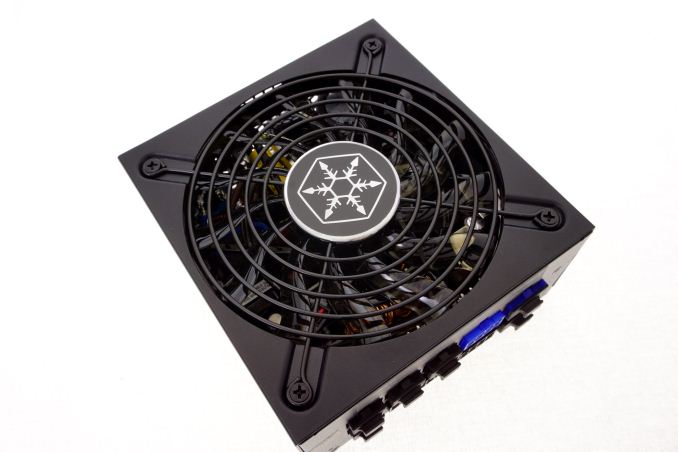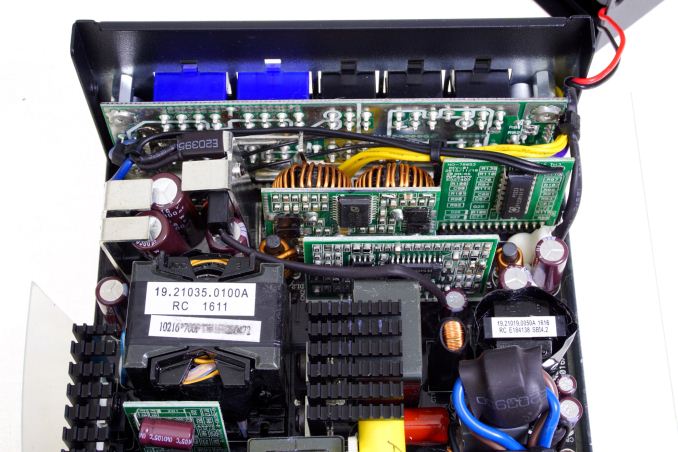The SilverStone SX700-LPT SFX 700W PSU Review
by E. Fylladitakis on September 30, 2016 9:00 AM EST- Posted in
- Cases/Cooling/PSUs
- PSUs
- SilverStone
- SFX
Conclusion
SilverStone is a company that is strongly focused on the design and marketing of SFF cases and related parts; therefore, it was only natural that they would strive to have the most powerful SFX PSU on the market. It is true that they might have “cheated” a little by extending the chassis by 25 mm and marketing it as an “SFX-L” unit, but it still is the most powerful 80Plus Platinum certified SFX PSU in existence up to this date.
The quality of the SX700-LPT is excellent, with Sirfa outdoing themselves building this model. The design is very clean and there were no manufacturing/assembling errors that we could notice. SilverStone is using top quality components, which is of critical importance in a design that it is expected to operate with relatively high internal temperatures. Poor quality products would cause a massive performance degradation in a very hot environment, but the SX700-LPT kept delivering a good quality output regardless of the very high ambient temperatures.
Meanwhile, the overall performance of the SX700-LPT is a slightly complicated matter. Compared to common ATX PSUs, the SX700-LPT's power quality is admittedly uninteresting and the noise output is too high. However by SFX standards, these are actually by far the best performance figures that we have ever recorded from a SFX PSU. Simply put, no other SFX PSU that we've tested has matched what SilverStone has done with the SX700-LPT. Further adding to the PSU's impressiveness, the SX700-LPT easily meets its 80Plus Platinum efficiency certification and works very well in room temperature. The only drawback to the design that we can find is that it will get stressed and end up being very loud inside a very hot environment; yet the PSU would be the least of one’s worries if an SFF gaming PC is this poorly cooled.
Interesting as it may be, it is clear that the SilverStone SX700-LPT SFX-L PSU is a very narrowly focused product. It has been designed for a very specific group of users, requiring a very high power output inside an SFF case while, at the same time, they own one of the few SFF cases that can support the extra length of the SX700-LPT. The retail price of $150 is high, but not unreasonable considering that this is the only SFX PSU that combines an output of 700 Watts with an 80Plus Platinum certification. This makes it a very niche product – gamers who want a high-performance SLI/CrossFire setup inside of a SFF case – which limits its market potential. But at least within that market, the SX700-LPT should easily excel.












48 Comments
View All Comments
usernametaken76 - Friday, September 30, 2016 - link
There's no edit feature, that should have read "one on a 120mm rad and the other on the case."Samus - Saturday, October 1, 2016 - link
That's true, I never thought of peak/spike draw. That has been an issue on AMD cards recently because their power circuitry cuts corner presumably on capacitance. This surges the PSU.However, I just can't imagine a single CPU system with any video card needs more than 500 watts, but there are obvious exceptions especially when overclocking or running more than a single drive.
usernametaken76 - Saturday, October 1, 2016 - link
There are 425W BIOS mods for the original TITAN X. I had one. It's definitely needed in some cases.xenol - Monday, October 3, 2016 - link
I don't see how that adds up considering the PCIe connectors should only be able to supply (within spec) 300W.TheinsanegamerN - Monday, October 3, 2016 - link
WITHIN SPEC is the key there. People flashing higher TDP mods to GPUs are running everything out of spec. That's the definition of overclocking.BrokenCrayons - Monday, October 3, 2016 - link
At the point where you're using a Titan, overclocking everything, and intentionally raising TDP limits, you're probably not putting your parts into an SFX case and probably not going to need to worry about the wattage limitations of power supplies available for that platform. That situation is at the extreme end of halo computing and represents a very small number of systems. People doing those things presumably understand what they're doing, but we're still talking about a very small portion of actual computer users.gopher1369 - Saturday, October 1, 2016 - link
"[I'm] seeing max load at the wall peaking at 290w"Assuming your PSU is 85% efficient then 290 x 0.85 = 246.5 Watts consumed.
wolfemane - Saturday, October 1, 2016 - link
Aaaaaaaaand your point being? Not sure I understand the relivence of your post. Maybe to make a minor grammatical correction and show off your math skills? Bravo I guessxenol - Monday, October 3, 2016 - link
And so was I, and the most it spiked up to was 250W.Stuka87 - Friday, September 30, 2016 - link
Its only rated for 40C?! That is not that hot, its very easy to get the insides of a PC case that high during heavy gaming.